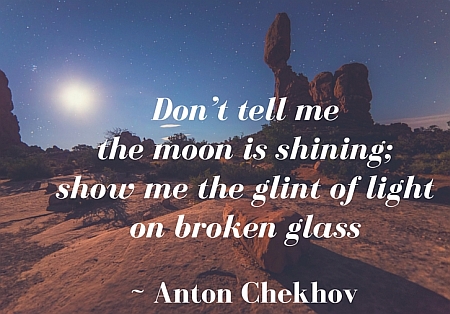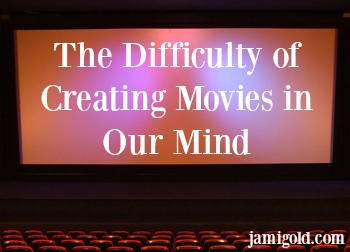Thank you to everyone who commented on my post last time about aphantasia, or “mind blindness.” As we discovered, not everyone can create a movie in their mind when writing or reading (which, as Davonne theorized, might explain why some don’t enjoy fiction).
But even for those of us without aphantasia, as writers, we can still struggle to create a well-rounded world or characters that feel real. Or as readers, we might never feel fully immersed in a story to get the whole movie-in-our-mind effect.
Those stories that feel like we can crawl in and inhabit them are often lauded as special. Sometimes people will even talk about a setting as though it’s another character to meet and experience. How many millions of readers want to visit Hogwarts or wish they received their own invitation letter?
For me as a reader, I judge how “good” a story is by how deeply I’m immersed in that mind-movie. (I’m a genre girl because literary fiction is often more writerly and less about storytelling that can pull me under the words themselves.) As an author, I often feel like my writing is flat if it doesn’t create that sense in me (even if the issue is really that I’ve read it too many times for the words to feel fresh anymore *smile*).
So while being able to create that movie-in-the-mind experience is the goal for many of us, we don’t always succeed—aphantasia or not. Why is this so hard?
The Complexities of Real-Life Movie Production
As we’re comparing books to mental movies, I thought we could have fun by taking a look at what goes into making a real-life movie and seeing just how many roles we have to juggle as writers. *smile*
The list of positions for a film crew can be huge. Per Wikipedia (emphasis added):
“A study of the 100 top-grossing films of each year between 1994 and 2013 found that there were an average of 588 crew credits per film, however, profitable independent films have been made with crews of less than a dozen.”
Even in an independent film, the crew might still consist of:
- Executive Producer: Provides the funding
- Producer: Coordinates all the business aspects
- Screenwriter: Writes the story and dialogue
- Production Designer: Translates the script into visual form
- Cinematographer: Captures the script visually, matching focus, lighting, framing, etc. to the director’s vision
- Editor: Organizes shots for pacing and flow
- Location Manager: Decides on the locations for each scene
- Art Director: Responsible for creating the film’s settings, from landscapes to props
- Costume Designer: Uses costuming to convey the time period or character traits
- Sound Designer: Ensures everything from dialogue to sound effects is captured or created
- Casting Director: Finds the right people to inhabit the characters
- Director: Oversees the shooting and assembly of the film
- Actors: Perform the story
There are far more film crew positions that we could talk about, but I wanted to highlight those because each of those functions has a place in fiction writing as well.
Authors Really Do It All
It’s not just our imagination that we have a lot to do when drafting a story. We really do do a lot because we’re wearing all the hats for those positions above.
- Executive Producer: If we’re an indie author, the funding angle is obvious, but even if we’re traditionally published, we still come up with the funding for writing workshops, conferences, mailing to agents/editors, etc. The job of an executive producer is to create the situation and circumstances that allow a movie to be made, and getting to the point of allowing a story to be written is on us no matter how we publish.
- Producer: As authors, we’re entrepreneurs, so we handle the business side of writing and publishing all the time. Even if we’re traditionally published, we’re still pursuing the business contacts to get an agent and/or editor on board.
- Screenwriter: Of course as an author, we’re responsible for actually writing the story. *smile*
- Production Designer: A film production designer might come up with storyboards to decide on the “look” of the movie. Storyboarding, mood, tone? Yep, that’s all us as authors too.
- Cinematographer: The director of photography brings the script to life by deciding what to focus on and how to use imagery to create emotions in the audience. Every note about a tremor in a character’s hands or a “glint of light on broken glass” (such as the common advice about showing vs. telling attributed to Anton Chekhov) directs the readers’ focus to what we want them to see. The showing we do in a story is like cinematography.

- Editor: A film editor rearranges scenes, figures out when to stop and start each scene, decides which take has the best expression of dialogue, etc. Authors do all those same functions to assemble the ideas for the story and characters in the best way to create a sense of emotion, story flow, and strong pacing.
- Location Manager: As authors, we have to decide on the best setting for each of our scenes. Would an indoor or outdoor setting increase the drama? Have we used one setting too often?
- Art Director: Like an art director, we have to make the settings come alive. Is weather affecting a scene? What props does the character fiddle with when deliberating that line? Is the furniture high-end or ratty? Our choices create the scene.
- Costume Designer: Like a costume designer, we have to decide what our characters’ sense of style is. Do they wear jeans or suits? In a historical story, we have to research the time period and proper terminology.
- Sound Designer: Like a cinematographer for visual aspects, a sound designer creates the auditory aspects of a story. As authors, we might create impressions of characters with their voices (deep, high-pitched, grating) or accent, or we might show certain aspects of the story through sounds.
- Casting Director: While a casting director searches for the best actors for characters, we have to find the best characters for our story. Which character will inhabit our story and bring the plot to life?
- Director: Not surprisingly, we’re also the director, overseeing the big picture of our story and making sure everything comes together to create the story we want.
- Actors: Actors in a movie must evoke emotions with their performance. For us as authors, we have to create the performance—the facial expressions, body language, etc.—that convince readers of the characters’ emotions.
All those aspects added together can create movies in the minds of our non-aphantasiac readers, but that’s obviously a lot of juggling we have to do to make it work. So it’s no wonder that sometimes one of our “hats” might be on a bit crooked and we need beta readers and editors to help us get everything in line. *smile*
Do you judge books by how deeply you experience the movie in your mind? Can you think of other movie film crew roles that we have to fill as authors? Do you enjoy some of those roles more than others? Do you struggle with some of those roles? Do you think that struggle affects your ability to create movies in your readers’ minds?

